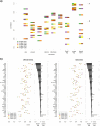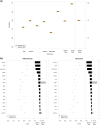Taboo language across the globe: A multi-lab study
- PMID: 38724878
- PMCID: PMC11133054
- DOI: 10.3758/s13428-024-02376-6
Taboo language across the globe: A multi-lab study
Abstract
The use of taboo words represents one of the most common and arguably universal linguistic behaviors, fulfilling a wide range of psychological and social functions. However, in the scientific literature, taboo language is poorly characterized, and how it is realized in different languages and populations remains largely unexplored. Here we provide a database of taboo words, collected from different linguistic communities (Study 1, N = 1046), along with their speaker-centered semantic characterization (Study 2, N = 455 for each of six rating dimensions), covering 13 languages and 17 countries from all five permanently inhabited continents. Our results show that, in all languages, taboo words are mainly characterized by extremely low valence and high arousal, and very low written frequency. However, a significant amount of cross-country variability in words' tabooness and offensiveness proves the importance of community-specific sociocultural knowledge in the study of taboo language.
Keywords: Best–worst scaling; Emotion; Semantics; Swearing; Taboo words.
© 2024. The Author(s).
Figures








References
-
- Allan K, Burridge K. Forbidden words: Taboo and the censoring of language. Cambridge University Press; 2006.
-
- Arnulf I, Uguccioni G, Gay F, Baldayrou E, Golmard JL, Gayraud F, Devevey A. What does the sleeping brain say? syntax and semantics of sleep talking in healthy subjects and in parasomnia patients. Sleep. 2017;40:zsx159. - PubMed
-
- Azzaro G. Taboo language in books, films, and the media. In: Allan K, editor. The Oxford handbook of taboo words and language. Oxford University Press; 2018. pp. 285–310.
-
- Baayen RH, Feldman LB, Schreuder R. Morphological influences on the recognition of monosyllabic monomorphemic words. Journal of Memory and Language. 2006;55:290–313.
-
- Balota DA, Chumbley JI. Are lexical decisions a good measure of lexical access? The role of word frequency in the neglected decision stage. Journal of Experimental Psychology: Human perception and performance. 1984;10:340–357. - PubMed
Publication types
MeSH terms
Grants and funding
LinkOut - more resources
Full Text Sources
Miscellaneous

